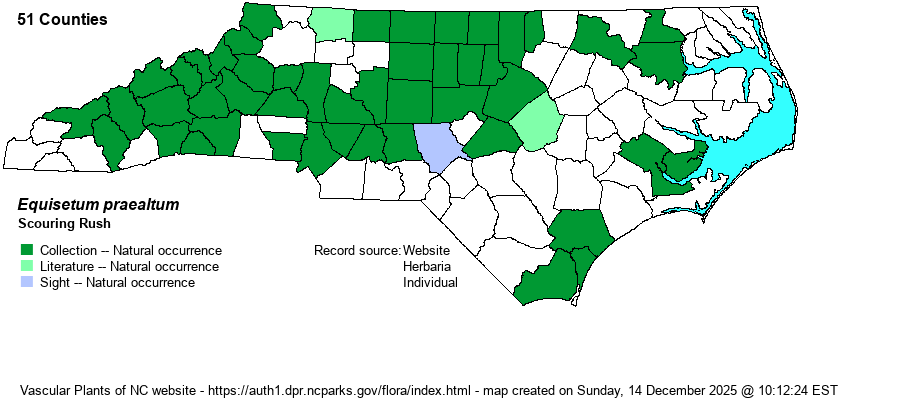| Author | Rafinesque | |
| Distribution | Throughout the Mountains and Piedmont; widely scattered over most of the Coastal Plain, but absent from the far eastern counties and some southern counties.
Ranges over the entire US and Canada.
| |
| Abundance | Fairly common to locally common in the Mountains; fairly common, at least locally, in the Piedmont; rare to locally uncommon in much of the Coastal Plain, very rare to absent in the far eastern and some southern counties. | |
| Habitat | This is a wetland species of openings or disturbed ground, such as in bottomland openings, along river shores, river banks, and stream banks, especially sites that are frequently scoured, and other damp ground. | |
| Phenology | Fruits from May to September. | |
| Identification | Unlike with E. arvense, this species has all stems similar and fertile. They are dark green and evergreen, unbranched, about 2.5-3 feet tall on average, in dense stands. The stems are rough to the touch. The numerous nodes have sheaths with very short teeth, barely noticeable. The cones at the stem tips are short, barely 1/2-inch tall. This species is easily identified by the dark green stalks, which are unbranched; the other native species -- E. arvense -- has the fertile stalks flesh-colored, whereas the sterile stalks are green but highly branched with very slender leaf segments. | |
| Taxonomic Comments | North American plants are now split from Eurasian E. hyemale (Weakley 2020). This includes plants formerly named E. hyemale ssp. affine.
| |
| Other Common Name(s) | Rough Horsetail, Scouring-rush Horsetail | |
| State Rank | S4 [S5] | |
| Global Rank | G5 | |
| State Status | | |
| US Status | | |
| USACE-agcp | | |
| USACE-emp | | |

